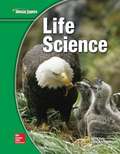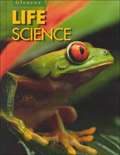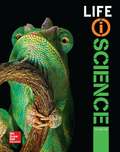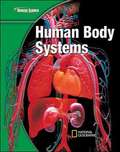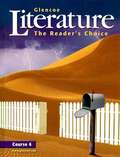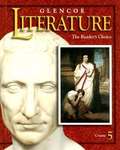- Table View
- List View
Glencoe Life Science
by Glencoe McGraw-Hill StaffWith a broad array of innovative print and technology resources, Glencoe Life Science helps teachers differentiate and accommodate all learners. The range of labs, content area reading, discussion strategies, note-taking tools, and activities provides students with multiple experiences of each Science Benchmark. They give teachers flexibility and the ability to monitor student progress through ongoing assessment.
Glencoe Life Science
by Glencoe McGraw-Hill StaffGlencoe Life Science a students edition: Covers the following units: Life Heredity and Evolution Diversity of Life Plants Animals Ecology The Human Body
Glencoe Life iScience
by Juli Berwald Michelle Anderson American Museum of Natural HistoryNIMAC-sourced textbook
Glencoe Life iScience
by Juli Berwald Michelle Anderson American Museum of Natural HistoryNIMAC-sourced textbook
Glencoe Life iScience
by McGraw-HillTopics broadly covered in this book are life structure & function, bacteria, plants, animals, human body systems and interactions of life.
Glencoe Life iScience Modules: Human Body Systems, Grade 7, Student Edition
by McGraw-Hill-Glencoe Staff"IScience meets students where they are through engaging features and thought-provoking questions that encourage them to relate the science concepts to the world around them.
Glencoe Literature - Course 5
by Jacqueline Jones Royster Beverly Ann Chin Jeffrey D. Wilhelm Douglas Fisher""The two most engaging powers of an author are to make new things familiar, and familiar things new." - Samuel Johnson (1709-1784)<P>"Glencoe Literature for 2002 also "makes new things familiar and familiar things new." Designed to meet the needs of today's classroom, "Glencoe Literature has been developed with careful attention to instructional planning for teachers, strategic reading support, and universal access that meets the learning needs of all students.
Glencoe Literature California Treasures, Course 3
by Jeffrey D. Wilhelm Douglas Fisher Kathleen A. Hinchman David G. O'Brien Taffy Raphael Cynthia Hynd ShanahanNIMAC-sourced textbook
Glencoe Literature California Treasures, Course 3, Expressions
by Glencoe Mcgraw-HillNIMAC-sourced textbook
Glencoe Literature California Treasures, Course 3, Read and Write Interactive [Approaching]
by Glencoe Mcgraw-HillNIMAC-sourced textbook
Glencoe Literature Course 4: The Readers Choice
by Jacqueline Jones Royster Beverly Ann Chin Jeffrey D. Wilhelm Douglas FisherGlencoe's Reader's Choice contains a wealth of information. The trick is to know where to look to access that information. If you go through this scavenger hunt, either alone or with teachers or parents, you will quickly learn how the textbook is organized and how to get the most out of your reading and study time.
Glencoe Literature Course 5: The Reader's Choice
by Beverly Ann Chin Denny Wolfe Jeffrey Copeland Mary Ann DudzinskiSet in line with the Glencoe's teaching standards this book provides a wide range of literature material.
Glencoe Literature Florida Treasures, Course 1
by Jeffrey D. Wilhelm Douglas Fisher Kathleen A. Hinchman David G. O'Brien Taffy Raphael Cynthia Hynd ShanahanNIMAC-sourced textbook
Glencoe Literature Georgia Treasures, Course 1
by Jeffrey D. Wilhelm Douglas Fisher Kathleen A. Hinchman David G. O'Brien Taffy Raphael Cynthia Hynd ShanahanNIMAC-sourced textbook
Glencoe Literature Georgia Treasures, Course 3
by Jeffrey D. Wilhelm Douglas Fisher Kathleen A. Hinchman David G. O'Brien Taffy Raphael Cynthia Hynd ShanahanNIMAC-sourced textbook
Glencoe Literature Georgia Treasures, Course 5
by Jacqueline Jones Royster Beverly Ann Chin Jeffrey D. Wilhelm Douglas FisherNIMAC-sourced textbook
Glencoe Literature Georgia Treasures: American Literature
by Jacqueline Jones Royster Beverly Ann Chin Jeffrey D. Wilhelm Douglas FisherNIMAC-sourced textbook
Glencoe Literature Grade 12: The Reader's Choice (California Edition)
by Glencoe Mcgraw-HillIn this lively collection of classic and contemporary literature, you will find much to amuse, surprise, delight, engage, and inform you. A wide variety of selections--including poems, plays, short stories, essays, autobiographies, and news articles on a broad range of themes--offers you the chance to hear talented authors in all their diversity, as well as to experience and learn about the people, places, and ideas that moved them.
Glencoe Literature Texas Treasures, Course 3
by Jeffrey D. Wilhelm Douglas Fisher Kathleen A. HinchmanNIMAC-sourced textbook
Glencoe Literature Texas Treasures, Course 4
by Beverly Ann Chin Jeffrey D. Wilhelm Douglas FisherNIMAC-sourced textbook
Glencoe Literature Texas Treasures, Course 5
by Beverly Ann Chin Jeffrey D. Wilhelm Douglas FisherNIMAC-sourced textbook
Glencoe Literature Texas Treasures: American Literature
by Beverly Ann Chin Jeffrey D. Wilhelm Douglas FisherNIMAC-sourced textbook
Glencoe Literature Texas Treasures: British Literature
by Beverly Ann Chin Jeffrey D. Wilhelm Douglas FisherNIMAC-sourced textbook
